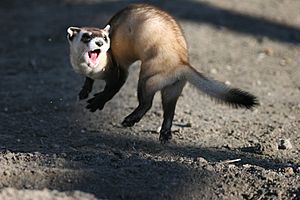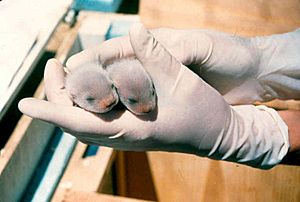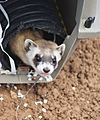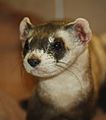Black-footed ferret facts for kids
Quick facts for kids Black-footed ferret |
|
|---|---|
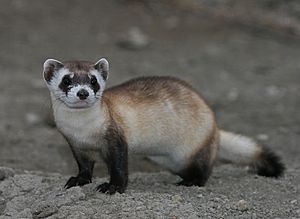 |
|
| Conservation status | |
| Scientific classification | |
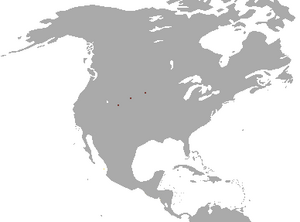 |
|
| Black-footed ferret range (three small areas on US territory) |
The black-footed ferret (Mustela nigripes) is a type of weasel. It is also known as the American polecat or prairie dog hunter. This animal lives in central North America. It is an endangered species, meaning it is at risk of disappearing forever.
Black-footed ferrets have several natural enemies. These include golden eagles, great horned owls, coyotes, American badgers, bobcats, prairie falcons, ferruginous hawks, and prairie rattlesnakes.
Contents
History of the Black-footed Ferret
Long ago, Native American tribes knew about black-footed ferrets. Groups like the Crow, Blackfoot, Sioux, Cheyenne, and Pawnee used them for religious ceremonies and as food.
Modern scientists did not discover the ferret until 1851. It was first described in a book by John James Audubon and John Bachman.
What Does a Black-footed Ferret Look Like?
The black-footed ferret has a long, thin body. It has black markings on its feet, ears, parts of its face, and its tail. Its neck is long, and its legs are short. The toes have sharp claws. Even the bottoms of its feet are covered with hair. This fur helps to hide its claws.
Male ferrets are about 50 to 53 centimeters (19.7 to 21.0 inches) long. Females are usually about 10% smaller than males. These ferrets weigh between 650 and 1,400 grams (1.43 to 3.09 pounds).
Their main color is a pale yellowish or buffy brown. The top of their head and sometimes their neck look darker because of dark-tipped hairs. A wide black band crosses their face, going around their eyes. Their feet, lower legs, and the tip of their tail are also black. A dark brown patch is found between their front and back legs. They have a small light spot above each eye and a thin band behind the black mask. The sides of their head and their ears are a dirty-white color.
How Black-footed Ferrets Behave
Black-footed ferrets usually live alone. They only come together to breed or to raise their young. They are nocturnal, meaning they are active at night. They mostly hunt for sleeping prairie dogs inside their burrows. They are most active above ground from evening until midnight, and again from 4 AM until mid-morning.
Weather usually does not stop ferrets from being active. However, in winter, they might stay inside their burrows for up to six days at a time. Ferrets may travel long distances, up to 11 miles (18 kilometers), to find enough food.
Reproduction and Development
Black-footed ferrets mate in February and March. A mother ferret can have one to five babies, called kits. Kits are born in May and June inside prairie dog burrows. Their mother takes care of them for several months.
Kits first come out of the burrow in July, when they are about six weeks old. Later, they move into their own separate prairie dog burrows near their mother's burrow. Kits grow to adult size and become independent between late August and October. They can start having their own babies when they are one year old.
What Do Black-footed Ferrets Eat?
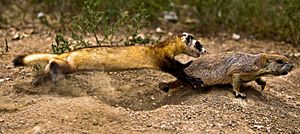
Up to 90% of a black-footed ferret's diet is made up of prairie dogs. The other 10% of their diet includes small rodents and rabbits. What they eat can change a little depending on where they live.
Where Black-footed Ferrets Live
In the past, black-footed ferrets lived across a wide area. This stretched from southern Alberta and southern Saskatchewan in Canada, all the way south to Texas, New Mexico, and Arizona in the United States.
By 2007, the only known wild black-footed ferret population was found in Wyoming. Since 1990, efforts have been made to bring black-footed ferrets back to many areas. These include places in Wyoming, Montana, South Dakota, Arizona, Colorado, and Canada.
Black-footed ferrets used to live in many different types of grasslands. This included short-grass prairies, mixed-grass prairies, and desert grasslands. They use the burrows of prairie dogs to raise their young, hide from predators, and stay warm.
Interesting Facts About the Black-footed Ferret
- In 2020, black-footed ferrets were part of a study for an experimental COVID-19 vaccine in Colorado.
- A study in 1983 found that one adult female ferret and her babies need a lot of prairie dogs to survive each year.
- Scientists have successfully cloned a black-footed ferret! In 2020, a team of scientists cloned a female ferret named Willa, who had died in the 1980s. Her clone, a female named Elizabeth Ann, was born on December 10, 2020. This made her the first endangered species in North America to be cloned.
- Activities like oil and natural gas drilling can harm black-footed ferrets. The vibrations from drilling can cause prairie dog burrows to collapse. Other problems include oil spills, more roads, and more human activity. Also, traps set for other animals like coyotes can accidentally harm ferrets.
Images for kids
-
Skull, as illustrated in Merriam's Synopsis of the weasels of North America
-
Black-footed ferret at the Louisville Zoo
-
Skeletons of black-footed ferret (left) and prairie dog (right) articulated to show the predator-prey relationship between the two. (Museum of Osteology)
See also
 In Spanish: Turón patinegro para niños
In Spanish: Turón patinegro para niños



